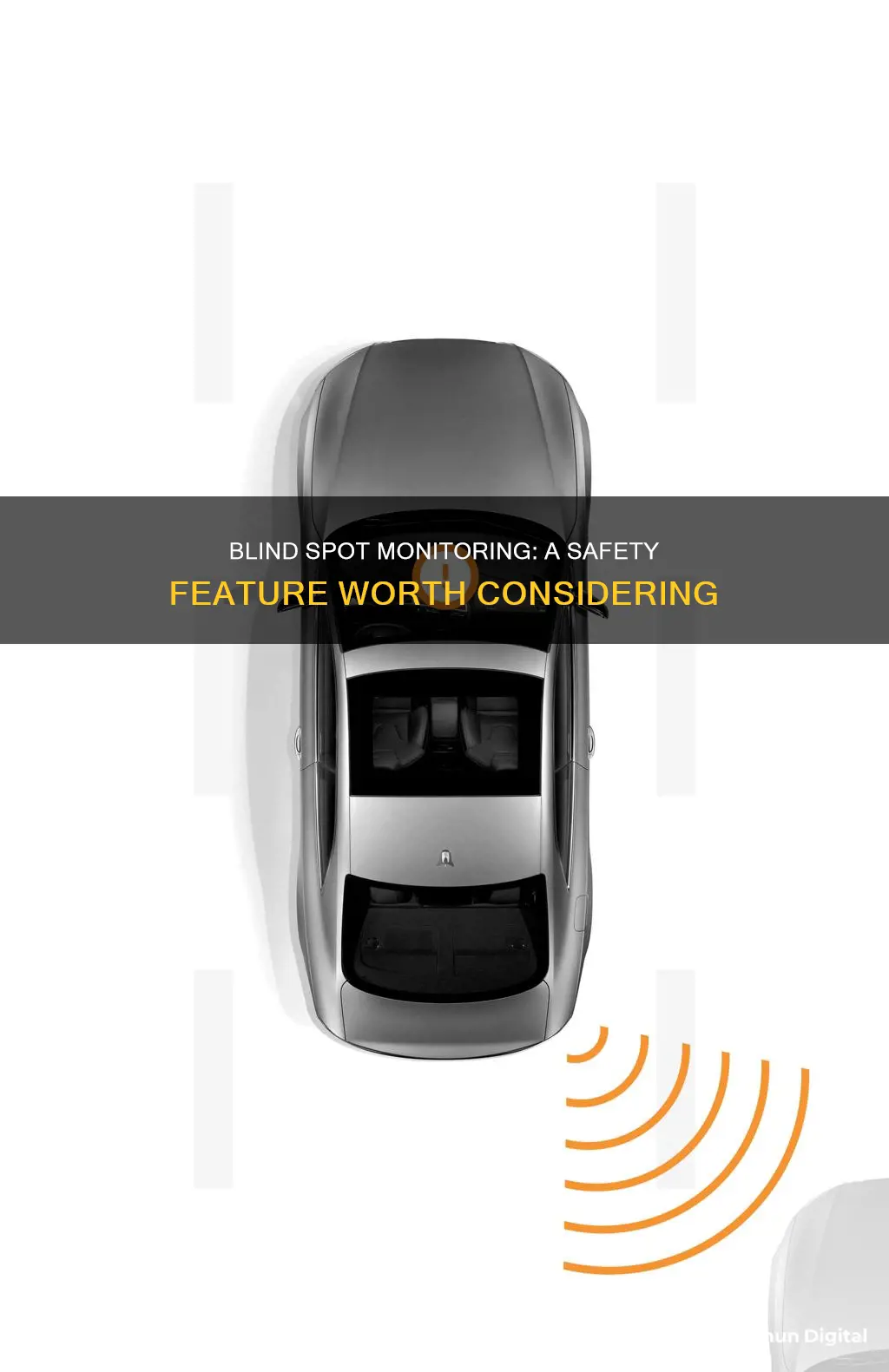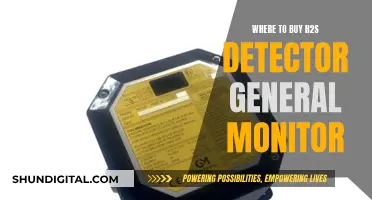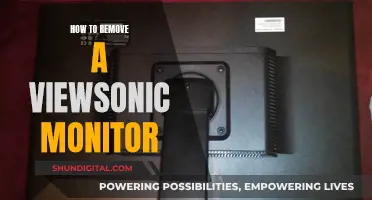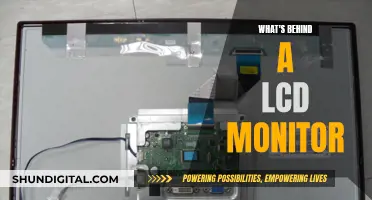
Blind-spot monitoring (BSM) is an advanced driver-assistance system designed to increase safety by alerting the driver to vehicles that may be hidden in the side-view mirrors. This technology helps prevent motorists from colliding with another car moving in the same direction in an adjacent lane. While BSM is not a substitute for checking mirrors and looking over one's shoulder, it offers added safety to compensate for human error. The system uses radar or ultrasonic sensors located in the rear bumper, as well as cameras in the side-view mirror housings, to detect vehicles within monitored areas. When activated, BSM typically provides a visual alert, such as a flashing light in the side-view mirror or head-up display, accompanied by an audible warning. More advanced BSM systems can also intervene with autonomous steering or braking to prevent collisions.
What You'll Learn
- Blind-spot monitoring systems can be purchased as an aftermarket add-on for older vehicles
- The systems use sensors and sometimes cameras to detect vehicles in a car's blind spot
- When a vehicle is detected, the driver is alerted through visual or audio warnings?
- Some systems also offer haptic feedback, such as vibrations through the steering wheel or seat
- Blind-spot monitoring is not a substitute for safe driving practices but can be a useful additional safety measure

Blind-spot monitoring systems can be purchased as an aftermarket add-on for older vehicles
Aftermarket blind-spot monitoring systems are available in a range of prices and can be purchased from retailers such as Amazon, Walmart, and Crutchfield. The cost of the system will depend on its accuracy and functionality, with more advanced systems featuring advanced controller programming to reduce the possibility of false alarms. Basic systems can be purchased for under $250, while mid-range systems typically cost between $250 and $500. The most advanced systems, with the highest reliability and accuracy, cost $500 or more.
Most aftermarket blind-spot monitoring systems are universal, meaning they can be used regardless of the age, make, and model of the vehicle. They typically consist of sensors that detect hazards in a vehicle's blind spots, and indicators that alert the driver to potential dangers. The sensors use a variety of technologies, including sonar, radar, and lidar, to sense the environment and detect hazards. The indicators typically use a combination of visual LED lights and audible alarms to notify the driver of potential dangers.
While it is possible to install an aftermarket blind-spot monitoring system yourself, professional installation is recommended. The installation process can be complex and may require removing the rear bumper and taillights of the vehicle.
Monitoring Oracle Temp Tablespace Usage: Tips and Tricks
You may want to see also

The systems use sensors and sometimes cameras to detect vehicles in a car's blind spot
Blind-spot monitoring (BSM) is a safety feature that uses sensors and sometimes cameras to detect vehicles in a car's blind spot. The system warns the driver of potential hazards in adjacent lanes, which can help prevent accidents and increase driving awareness. BSM is now offered as a standard or optional feature in many vehicles across different price ranges, from subcompact cars to large trucks and SUVs.
BSM systems use sensors mounted on the side mirrors or rear bumper to detect vehicles in the adjacent lanes. These sensors can be radar, ultrasonic, sonar, lidar, or camera-based, and they trigger an alert when a vehicle enters the blind spot. The indicators in BSM systems typically include visual warnings, such as a yellow warning light on the side mirror or the vehicle's A-pillar, and/or audible alerts, like a chime. Some systems also provide steering assistance by manipulating the steering and brakes to avoid a potential collision.
The effectiveness of BSM depends on proper installation and maintenance. Sensors and cameras should be kept clean and free of debris, and the system's limitations should be understood. While BSM can provide valuable assistance, it is not a substitute for proper mirror usage and checking blind spots manually.
Aftermarket BSM kits are available for older vehicles that lack this technology. These kits typically include sensors, indicators (visual and/or audible), and magnets for mounting. Professional installation is recommended to ensure proper functionality.
Asus ROG Monitors: Unlocking HDR Performance
You may want to see also

When a vehicle is detected, the driver is alerted through visual or audio warnings
Blind-spot monitoring (BSM) is a safety feature designed to alert drivers of vehicles in their blind spots. Blind spots are areas on either side of a car that the driver cannot see when looking into the rearview or side-view mirrors. When a vehicle is detected in the blind spot, the driver is alerted through visual or audio warnings.
BSM systems use radar or ultrasonic sensors located inside the left and right sides of the rear bumpers, as well as cameras in the side-view mirror housings, to detect vehicles within their monitored areas. When a passing vehicle approaches and potentially enters a blind spot, the system advises the driver of its presence through a visual or audible alert, or both. Visual alerts may include a flashing light or illuminated icon in the side-view mirror, gauge cluster, or head-up display. Audible alerts typically consist of beeping tones or repeating chimes. Some systems also offer haptic alerts, such as vibrations through the steering wheel or seat.
In addition to alerting the driver, more advanced BSM systems can also provide autonomous steering or braking input to prevent collisions. These systems may nudge the driver away from the lane marker or steer them back to the centre of the lane. While these systems offer collision prevention functionality, the driver always maintains absolute control and can manually override the feedback.
While BSM is a valuable safety feature, it is not a substitute for checking mirrors and looking over one's shoulder. It is important for drivers to remain vigilant and utilize defensive driving skills, even when equipped with BSM.
Monitoring Home WiFi Usage: An Xfinity User's Guide
You may want to see also

Some systems also offer haptic feedback, such as vibrations through the steering wheel or seat
Blind-spot monitoring systems (BSM) are advanced driver assistance systems (ADAS) designed to increase safety by alerting the driver to vehicles that may be in their blind spots. While BSMs typically use visual or auditory alerts, some systems also offer haptic feedback in the form of vibrations through the steering wheel or seat. This added sensory layer can enhance the effectiveness of BSMs, particularly in noisy environments or for drivers who are visually impaired.
Haptic feedback in BSMs can take the form of either a rumble or a counter-steering force on the steering wheel. A rumble feature provides a general warning to the driver about vehicles in their blind spots. On the other hand, counter-steering force feedback actively intervenes to prevent lane changes or steering that could lead to a collision. This type of haptic feedback has been shown to significantly reduce blind-spot-related collisions in driving simulations.
While haptic feedback in BSMs can improve safety, it should not be relied upon as the sole means of monitoring blind spots. Drivers should still use their turn signals and look over their shoulders before changing lanes. Additionally, BSMs have limitations, such as only functioning at speeds above 20-35 mph, and may not detect vehicles travelling at significantly higher speeds.
Monitor Size for Music Production: How Big is Best?
You may want to see also

Blind-spot monitoring is not a substitute for safe driving practices but can be a useful additional safety measure
Blind-spot monitoring (BSM) is an advanced driver-assistance system designed to increase safety by alerting the driver to vehicles that may not be visible in their side-view or rearview mirrors. While BSM is a useful feature, it is not a substitute for safe driving practices such as checking mirrors, using turn signals, and looking over one's shoulder before changing lanes.
BSM typically uses sensors and sometimes cameras mounted on the side mirrors or rear bumper to detect vehicles in adjacent lanes. When a vehicle enters the driver's blind spot, BSM provides a visual, audible, or haptic alert to warn the driver. Some systems even offer autonomous steering or braking to prevent collisions, but the driver always maintains absolute control and can override this feedback manually.
BSM is especially useful for larger vehicles with bigger blind spots. It can also be beneficial when towing a trailer, as some systems can detect attached trailers and monitor traffic alongside them. Additionally, BSM often pairs with rear cross-traffic alert systems, which use the same sensors and cameras to detect obstacles when reversing.
Despite its benefits, BSM has some limitations. It may not detect fast-moving vehicles or motorcycles efficiently, and it may not function properly if its sensors or cameras are obstructed by dirt, snow, or condensation. Therefore, BSM should be used as a supplementary safety measure rather than a replacement for safe driving practices.
To maximise the effectiveness of BSM, it is essential to keep the sensors and cameras clean and properly aimed. Additionally, drivers should be aware of the system's limitations and continue to use their mirrors and perform visual checks when changing lanes or merging. While BSM is a valuable tool, safe driving practices are still the driver's primary responsibility.
Finding Monitor Names: A Simple Guide to Locate Your Screen Identity
You may want to see also
Frequently asked questions
Blind-spot monitoring (BSM) is an advanced driving assistance system (ADAS) designed to increase safety by alerting the driver to vehicles that may have escaped visibility in the side-view mirrors. It uses radar or ultrasonic sensors located inside the left and right sides of the rear bumpers, as well as cameras in the side-view mirror housings, to detect vehicles within blind spots.
When a passing vehicle approaches and potentially enters a blind spot, BSM advises the driver of the vehicle's presence through a visual indicator (an illuminated icon or flashing light in the side-view mirror, gauge cluster, or head-up display) and/or an audible warning (a beeping tone or repeating chime). More sophisticated systems may also provide a haptic alert (vibration through the steering wheel or seat) or even intervene with subtle autonomous steering or braking to prevent a collision.
Blind-spot monitoring is generally effective in reducing the occurrence of lane-change crashes and related injuries. However, it may struggle with detecting fast-moving vehicles and motorcycles, and it is not a substitute for safe driving practices such as checking mirrors and using turn signals.







